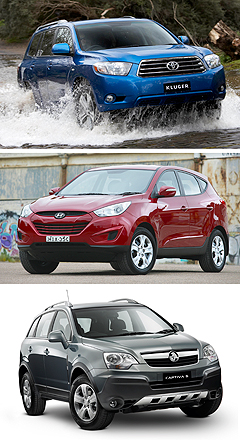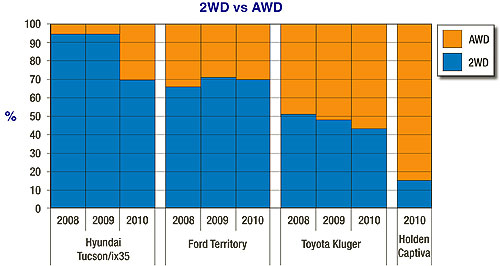Make / Model Search
News - General News - SalesFaux-wheel drive to the foreWagon substitute: Almost a third of Ford Territory buyers choose the two-wheel drive version. Toyota lines up to cash in on consumer shift to two-wheel drive SUVs with RAV426 Apr 2010 TOYOTA Australia’s imminent entry into the burgeoning front-wheel-drive compact SUV segment, via the first front-drive RAV4 sold here, is proof that no volume car-maker can afford to ignore the sizeable consumer shift towards crossover wagons as substitutes for the traditional family sedan. Hyundai turned the small SUV market on its head in Australia when it launched the front-drive Tucson City in October 2005, a little over a year after the Korean brand’s giant-killing compact crossover went on sale here (in July 2004). Lower running costs, a versatile wagon body that already eclipsed most small cars (few of which remained available as a wagon, even then) in terms of interior space and, most importantly, a bargain-basement entry price saw the City quickly account for the lion’s share of Tucson sales. In fact, while all-wheel drive versions of this year’s new ix35 have grown to comprise 30 per cent of Hyundai’s compact SUV sales since the model replaced the Tucson in February this year, in the past two years of Tucson sales a massive 94 per cent were front-drive City versions. Last year, no fewer than 11,405 Australians bought a Tucson, giving Hyundai a 13.5 per cent share of the only SUV segment not to shrink considerably in 2009. It was enough for the Tucson to be the nation’s third best selling model in Australia’s largest SUV segment, which attracted almost 85,000 buyers last year.  From top: Toyota Kluger, Hyundai ix35 and Holden Captiva. From top: Toyota Kluger, Hyundai ix35 and Holden Captiva.Relegated to an uncharacteristic second place, however, was Toyota’s once-dominant RAV4 (12,635 sales for a 14.9 per cent segment share), which was roundly beaten to the compact SUV sales gong by Subaru’s middle-aged Forester. Of course, the Forester, which found 13,753 homes for an unbeaten 16.3 per cent segment lead, is unlikely to ever follow the 2WD trend even if such a version became available to Subaru Australia, which has achieved stellar success with its AWD-only marketing catchcry. The Forester, RAV4 and ix35 will soon be matched by 2WD and AWD versions of the all-new Sportage from fellow Korean maker Kia, while Nissan and Renault continue to offer cut-price 2WD versions of its respective Dualis and Koleos compact SUVs. Mazda last year released a 2WD version of its more expensive CX-7, which has lifted sales considerably this year, while Holden recently added a front-drive SUV variant in the shape of the four-cylinder, five-seat Captiva ‘5’, which is effectively a compact SUV with a starting price of $27,990. RAV4 sales were down 10.5 per cent in Australia last year and sales of both the RAV and Forester have remained relatively static so far this year, but in the first two months of 2010 the CX-7, Dualis and Sportage registered sales surges of well over 200 per cent. Of course, two-wheel drive has long played a significant role in the medium SUV arena too, with Australia’s only locally built SUV leading the way. Ford Australia’s Territory has become a quasi family wagon for customers disenfranchised by the lack of a cutting edge Falcon wagon. While Holden’s relatively new Captiva 5, which sells alongside the popular Commodore Sportwagon, has attracted only a 15 per cent share of overall sales, some 66 per cent of all Territory models sold were rear-drive in 2008, increasing to 71 per cent in 2009 and 69 per cent so far in 2010. The addition of a 2WD version of the RAV4 follows a similar move made by Toyota with the launch of its second-generation Kluger medium SUV here in August 2007. Following the demise of the Camry wagon, the Kluger has become a family wagon substitute for many, with 2WD versions accounting for 51 per cent in 2008, 48 per cent in 2009 and 43 per cent so far this year. Toyota’s four-wheel-drive Prado may have been Australia’s top-selling SUV last year, but with 12,848 Klugers, 11,504 Captivas and 10,884 Territorys sold in 2009, 2WD medium SUVs attracted more than 15,000 buyers last year. Now, Australia’s top-selling vehicle brand will apply the same strategy in the compact SUV category with its first 2WD RAV4 which – despite legitimate protests from Suzuki, whose Vitara emerged five years before the first RAV4 in 1989 – continues to be billed as “the original SUV”. As GoAuto has revealed in recent weeks, a 2WD RAV similar to the one that has been available in the US since the current model’s launch in 2006 (but without its larger new 2.5-litre engine) will soon join Toyota’s Australian range, priced almost $5000 lower than the cheapest AWD RAV previously available. As we have reported, like its AWD sibling, the front-drive RAV will seat up to five people, offer a towing capacity of 1500kg (750kg unbraked) and come with identical specification levels to the regular RAV. Even though the standard RAV4’s part-time AWD system drives only the front wheels if the rear tyres break traction, the 2WD version reduces drivetrain friction and kerb weight by around 30kg, reducing official average fuel consumption from 9.6 litres per 100km to 9.1L/100km (auto) and from 9.1 to 8.4L/100km (manual). Backed by an expensive advertising campaign, we predict buyers will flock to the cheaper, more frugal RAV4 in their droves, just as they did to the Tucson City. Whether there will be enough of them for the RAV to outsell not only the Forester but the $2000 more affordable ix35 2.0 2WD – supported by AWD 2.4 petrol and AWD diesel variants – only time will tell.  Read more |
Click to shareGeneral News articlesResearch General News Motor industry news |












Facebook Twitter Instagram